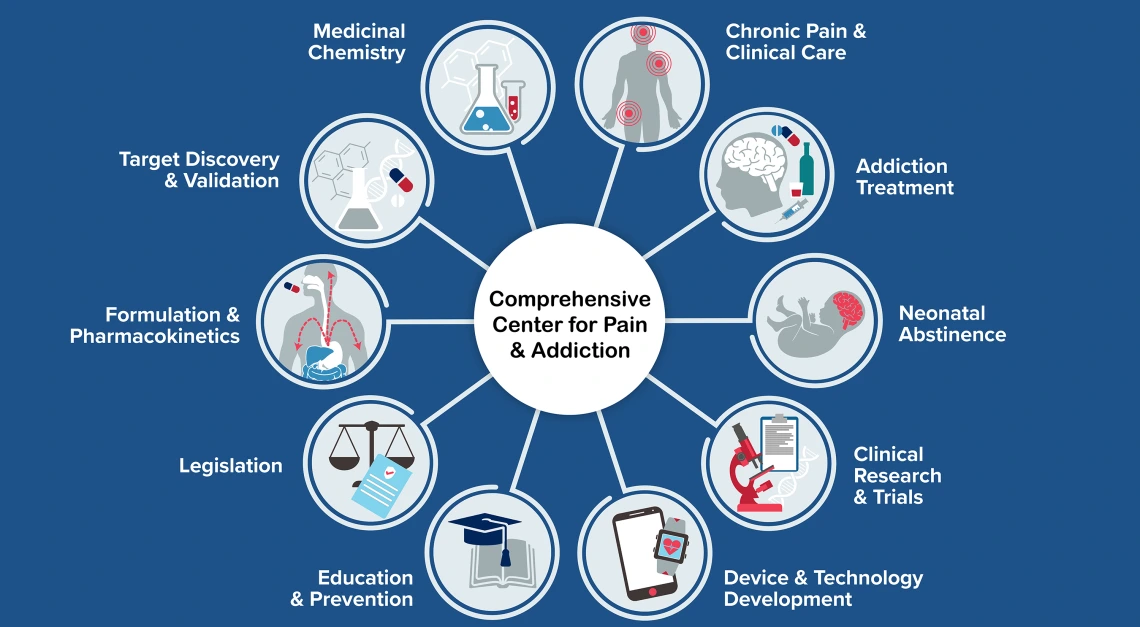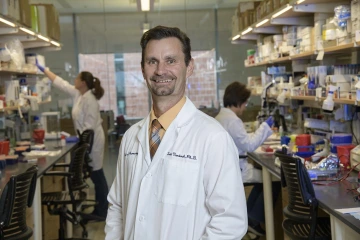Comprehensive Center for Pain & Addiction Takes Aim at Opioid Epidemic
A new University of Arizona Health Sciences center is creating a team of experts to tackle the diverse yet related issues of substance misuse, chronic pain and addiction.

The issues surrounding the opioid epidemic are complex, which is why the Comprehensive Pain and Addiction Center will take a multifaceted approach to finding a solution.
In the early 2010s, public awareness of a growing opioid crisis began building. By 2017, the U.S. Department of Health and Human Services declared a public health emergency to address the opioid epidemic, which is responsible for the deaths of more than 47,000 people a year in the U.S. While information about the opioid epidemic often focuses on those deaths and the misuse of and addition to opioids, the issue is complex and finding a solution will require a multifaceted mindset and approach.
That’s where the University of Arizona Health Sciences Comprehensive Center for Pain & Addiction comes in. The center will address the opioid epidemic from all angles, including addiction, chronic pain, education, legislation, clinical trials and research.
“Everybody seems to know somebody with an addiction problem,” said Todd Vanderah, PhD, department head and Regents Professor of pharmacology in the UArizona College of Medicine - Tucson. Vanderah spearheaded the strategic initiative to develop the Comprehensive Center for Pain & Addiction at UArizona Health Sciences.
“We have several core groups of faculty here who are probably some of the leading groups of faculty working on the topics of chronic pain, addiction and neonatal abstinence,” Vanderah said. "The Comprehensive Center for Pain & Addiction is an opportunity to pull multiple groups together as a team in moving forward.”

The center will address the opioid epidemic from several fronts, ranging from preclinical and clinical research to clinical care, education, legislation and technology development.
Approximately 100 million people in the U.S. are affected by chronic and acute pain, which negatively impacts people’s lives in significant ways and increases rates of morbidity, mortality and disability. Yet, Vanderah says, “We don’t do a great job in treating chronic pain, since physicians have been limited to the idea of simply prescribing an opiate.’”

Todd Vanderah, PhD, is working to unite University of Arizona experts in pain, addiction, biomedical engineering, outreach and drug development under the umbrella of the Comprehensive Center for Pain and Addiction.
Consequently, many scientists, Vanderah included, are researching alternatives to opioids for managing chronic pain and testing those novel molecular compounds in preclinical studies at UArizona. The Comprehensive Center for Pain & Addiction offers researchers an opportunity to build on those preclinical tests through medicinal chemistry, drug formulation and pharmacokinetics, and, potentially, clinical trials of Food and Drug Administration-approved investigational new drugs.
“There’s an opportunity to have not only preclinical research, which a lot of us do, but also a component that would be clinical, so that we can actually work with the clinicians here to help people with chronic pain and addiction,” said Vanderah, who is a member of the university's BIO5 Institute. “It would be like a dream to go from the chemistry of actually making new compounds, all the way through to patient trials and getting something accepted by the FDA for use worldwide.”
The Comprehensive Center for Pain & Addiction also will foster collaborations with biomedical engineers to develop devices and technologies to help predict and prevent substance abuse, as well as help save people’s lives in overdose situations. The administration of naloxone and suboxone, used to treat opioid overdose and addiction situations, requires special training, which will also be provided through the center.
“I think many physicians don’t know enough about opiates and addiction, but also it’s getting the information to the public and in the schools,” says Vanderah, who counts outreach and education as one of the center’s vital missions. “I think the biggest impact the new center will have is on our community here, in the state of Arizona. We can help the community with their chronic pain. We can help with understanding one’s addiction(s), and we can get education out to everybody to better understand how these things can influence the health and wellbeing of patients, their families and friends.”
Our Experts
Contact
Stacy Pigott
Office of Communications
520-621-7239
spigott@arizona.edu

